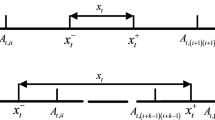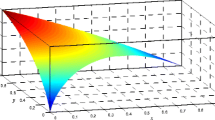Abstract
Discrete-valued belief structures (DBSs) (known as discrete belief structures) are universal in real life, differ from precise-valued belief structures, and interval-valued belief structures (IBSs). However, the combination of different discrete belief structures presents a problem that has yet to be solved. Therefore, this study investigated the respective counter-intuitive types of behavior associated with the combination of discrete belief structures within the frameworks of the Dempster-Shafer theory. (DST) evidential reasoning (ER) for the purpose of constructing a more general method for the combination and normalization of discrete evidence. Finally, an experimental application is provided to indicate that the proposed method is suitable for combining and normalizing conflict-free/conflicting discrete evidence, and can effectively solve problems involving group decision-making (GDM) with uncertain preference ordinals, such as in a software selection problem.


Similar content being viewed by others
Explore related subjects
Discover the latest articles and news from researchers in related subjects, suggested using machine learning.References
Dempster AP (1967) Upper and lower probabilities induced by a multivalued mapping. Ann Math Stat 38:325–339
Shafer G (1976) A mathematical theory of evidence. Princeton University Press, Princeton
Telmoudi A, Chakhar S (2004) Data fusion application from evidential databases as a support for decision making. Inf Softw Technol 46:547–555
Dou Z, Sun Y, Lin Y (2014) The optimization model of target recognition based on wireless sensor network. Int J Distributed Sensor Networks 10:2885–2888
Beynon M, Cosker D, Marshall D (2001) An expert system for multi-criteria decision making using Dempster Shafer theory. Expert Syst Appl 20:357–367
Wang YM, Yang JB (2006) Environmental impact assessment using the evidential reasoning approach. Eur J Oper Res 174:1885–1913
Liu ZG, Pan Q, Dezert J (2013) Evidential classifier for imprecise data based on belief functions. Knowl-Based Syst 52:246–257
Xu PD, Deng Y et al (2013) A new method to determine basic probability assignment from training data. Knowl-Based Syst 46:69–80
Frikha A (2014) On the use of a multi-criteria approach for reliability estimation in belief function theory. Information Fusion 18:20–32
Bazargan-Lari MR (2014) An evidential reasoning approach to optimal monitoring of drinking water distribution systems for detecting deliberate contamination events. J Clean Prod 78:1–14
Zhang YJ, Deng XY et al (2012) Assessment of E-commerce security using AHP and evidential reasoning. Expert Syst Appl 39:3611–3623
Yang JB, Singh MG (1994) An evidential reasoning approach for multiple attribute decision making with uncertainty. IEEE Trans Syst, Man, Cybernetics 24:1–18
Fu C, Wang YM (2015) An interval difference based evidential reasoning approach with unknown attribute weights and utilities of assessment grades. Comput Ind Eng 81:109–117
Du YW, Yang N, Ning J (2018) IFS/ER-based large-scale multiattribute group decision-making method by considering expert knowledge structure. Knowledge Based Syst 162:124–135
Monney PA (2003) Analyzing linear regression models with hints and the Dempster-Shafer theory. Int J Intell Syst 18:5–29
Petit-Renaud S, Denoeux T (2004) Nonparametric regression analysis of uncertain and imprecise data using belief functions. Int J Approx Reason 35:1–28
Liu J, Yang JB et al (2004) Fuzzy rule-based evidential reasoning approach for safety analysis. Int J Gen Syst 33:183–204
Zhang LM, Ding LY et al (2017) An improved Dempster-Shafer approach to construction safety risk perception. Knowl-Based Syst 132:30–46
Fu C, Huhns M, Yang SL (2014) A consensus framework for multiple attribute group decision analysis in an evidential reasoning context. Information Fusion 17:22–35
Zhang D, Yan XP et al (2016) Use of fuzzy rule-based evidential reasoning approach in the navigational risk assessment of inland waterway transportation systems. Saf Sci 82:352–360
Xu XB, Zheng J et al (2017) Data classification using evidence reasoning rule. Knowl-Based Syst 116:144–151
Polat G, Cetindere F, Damci A, Bingol BN (2016) Smart home subcontractor selection using the integration of AHP and evidential reasoning approaches. Procedia Eng 164:347–353
Kong GL, Xu DL et al (2016) Belief rule-based inference for predicting trauma outcome. Knowl-Based Syst 95:35–44
Kong GL, Xu DL et al (2015) Combined medical quality assessment using the evidential reasoning approach. Expert Syst Appl 42:5522–5530
Wang YM, Elhag TM (2007) A comparison of neural network, evidential reasoning and multiple regression analysis in modelling bridge risks. Expert Syst Appl 32:336–348
Yang JB, Xu DL (2013) Evidential reasoning rule for evidence combination. Artif Intell 205:1–29
Wang YM, Yang JB, Xu DL, Chin KS (2006) The evidential reasoning approach for multiple attribute decision analysis using interval belief degrees. Eur J Oper Res 175:35–66
Wang YM, Yang JB et al (2007) On the combination and normalization of interval-valued belief structures. Inf Sci 177:1230–1247
Sevastianov P, Dymova L, Bartosiewicz P (2012) A framework for rule-base evidential reasoning in the interval setting applied to diagnosing type 2 diabetes. Expert Syst Appl 39:4190–4200
Song YF, Wang XD et al (2014) Combination of interval-valued belief structures based on intuitionistic fuzzy set. Knowl-Based Syst 67:61–70
Zhang XX, Wang YM, Chen SQ, Chu JF (2019) Evidential reasoning rule for interval-valued belief structures combination. J Intell Fuzzy Syst 37:2231–2242
Zhang XX, Wang YM, Chen SQ, Chen L (2019) On the combination and normalization of conflicting interval-valued belief structures. Comput Ind Eng 137:106020. https://doi.org/10.1016/j.cie.2019.106020
Chen SQ, Wang YM et al (2018) Evidential reasoning with discrete belief structures. Information Fusion 41:91–104
Smets P, Kennes R (1994) The transferable belief model. Artif Intell 66:191–234
Liu WR (2006) Analyzing the degree of conflict among belief functions. Artif Intell 170:909–924
Chen SQ, Wang YM et al (2017) Alliance-based evidential reasoning approach with unknown evidence weights. Expert Syst Appl 78:193–207
Lee SG, Ma YS, Thimm GL, Verstraeten J (2008) Product lifecycle management in aviation maintenance, repair and overhaul. Comput Ind 59:296–303
Tang DB, Qian XM (2008) Product lifecycle management for automotive development focusing on supplier integration. Comput Ind 59:288–295
González-Pachón J, Romero C (2001) Aggregation of partial ordinal rankings: an interval goal programming approach. Comput Oper Res 28:827–834
Fan ZP, Liu Y (2010) An approach to solve group-decision-making problems with ordinal interval numbers. IEEE Trans Syst Man Cybernetics 40:1413–1423
Fan ZP, Yue Q, Feng B, Liu Y (2010) An approach to group decision-making with uncertain preference ordinals. Comput Ind Eng 58:51–57
Dopazo E, Martnez-Cspedes ML (2017) Rank aggregation methods dealing with ordinal uncertain preferences. Expert Syst Appl 78:103–109
Acknowledgements
This work is supported by the National Natural Science Foundation of China (NSFC) under the Grant No. 61773123 and 71801050, the National Social Science Foundation of China (19BGL016), New Century Excellent Talents Support Program of Fujian Higher Education Institutions (Fujian education department [2018] No.47), and the Anhui Provincial Planning Project of Philosophy and Social Science (AHSKQ2019D024).
Author information
Authors and Affiliations
Corresponding author
Additional information
Publisher’s note
Springer Nature remains neutral with regard to jurisdictional claims in published maps and institutional affiliations.
Rights and permissions
About this article
Cite this article
Zhang, XX., Wang, YM., Chen, SQ. et al. Discrete-valued belief structures combination and normalization using evidential reasoning rule. Appl Intell 51, 1379–1393 (2021). https://doi.org/10.1007/s10489-020-01897-9
Published:
Issue Date:
DOI: https://doi.org/10.1007/s10489-020-01897-9




